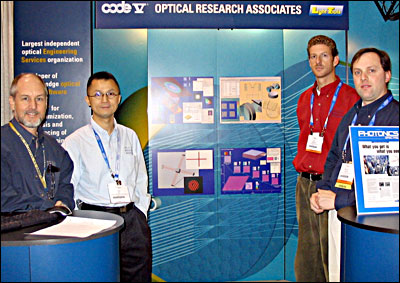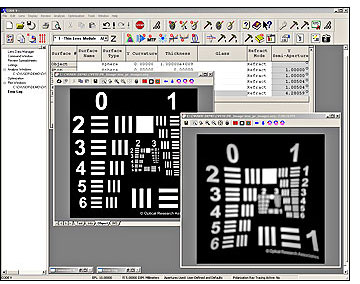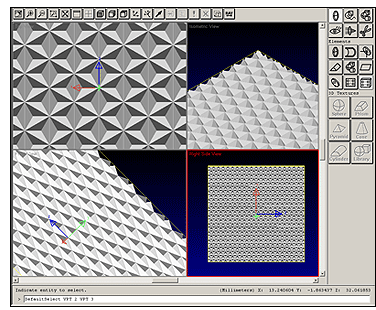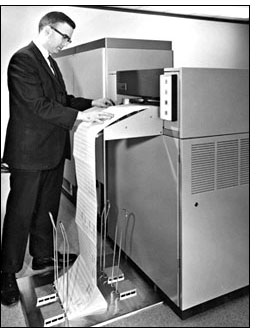PASADENA, Calif., Feb. 15, 2007 -- Engineers of a certain age might remember visiting Optical Research Associates' Pasadena office in the early 1970s to use what's now known around the world as Code V, a popular software program for optical design and engineering.
Founded in 1963 as an engineering services company, Optical Research Associates (ORA) now has a staff of 88, with offices in Pasadena, Calif.; Tucson, Ariz.; and Westborough, Mass.
ORA began developing commercial software after its in-house optical design code became popular. "In the early '70s, engineers came from as far away as Japan to use our software," said David Hasenauer, ORA’s Code V product manager. "In 1975, we launched Code V as a commercial product that they could install at their facility to do optical design. Code V has been under continuous development since then, and it remains a very active and dynamic product."
In 1994, ORA introduced LightTools, a software product with a CAD-like interface to perform virtual prototyping and simulations of nonimaging and illumination systems.
Optical Research Associates (ORA), supplier of Code V and LightTools imaging and illumination design/analysis software and engineering services, recently released version 9.70 of Code V and version 5.4.0 of LightTools. It exhibited at the SPIE Photonics West trade show, held in January in San Jose. Left to right: David Hasenauer, Code V product manager; Yibo Du, LightTools sales engineer; Jay Wilson, Code V sales engineer; and Stuart David, manager, software sales. ORA has offices in Westborough, Mass., Pasadena, Calif., and Tucson, Ariz. Its Engineering Services Group is the largest independent supplier of optical systems design, with more than 4500 completed projects in imaging, illumination and optical systems engineering.
“In many ways, the design and evaluation of nonimaging systems is a much more difficult problem than getting all the light to go to the same point,” said Bruce “Jake” Jacobsen, LightTools product manager. “In recent years, we have added optimization, photorealistic rendering, fast ray traceable 3-D surface texturing, and many other capabilities to LightTools’ suite of capabilities. Unlike competitive products that simply analyze performance, LightTools can alter the design automatically to improve performance for applications such as backlight displays, light pipes and others. It really is a design and analysis tool.”
John Tamkin, the group's director of imaging engineering, said, "ORA software benefits greatly from having an in-house engineering services group. Engineering services make for a better software product, because we're working on cutting-edge problems in both imaging and illumination areas and can help define the development of the software to solve real-world customer problems."
ORA’s engineering services group has completed more than 4500 designs for its customers on projects from telescopes to microscopes to kids’ toys, along with many "highly proprietary" ones, Tamkin added. "We can help customers across the full technical spectrum. I've had customers with bleeding-edge technology problems that want us to help them get to the next level or those who have an idea of an optical device but who don't know where to go from there."
ORA's engineering services team has completed projects for government, commercial and consumer products, including breakthrough designs for compact disk player optics, holographic heads-up displays and precision illumination systems. It also forms partnerships with manufacturers to deliver design-to-build optical solutions.
According to the company’s Web site, "Years before the actual introduction of CD players, ORA engineers helped pioneer the development of optics for this and other consumer products that now seem rather commonplace."
At the other extreme, ORA played a key role in the design and implementation of all of the primary null lenses used in the Hubble Space Telescope's first servicing mission, dramatically improving its image quality. For this and other work over the past 25-plus years, ORA was awarded NASA's Public Service Group Achievement award in 1995 -- the only privately held company to be so honored that year. ORA has also won many industry awards for product innovations in the field of optical design software.
"All of our engineers have substantial manufacturing experience," said Tamkin -- an optical scientist himself -- "which is unusual. Being able to create a baseline optical design is science or engineering, but creating a design that is manufacturable is business.”
Software Innovations
The focus on manufacturability also applies to ORA software development. There have been extensive improvements to Code V's capabilities over the years, Hasenauer said. “Two of the core strengths of Code V are its optimization and tolerancing capabilities. Code V includes an extremely fast and accurate wavefront differential method for determining the effects of tolerances on optical system performance. This can be 100x to 1000x times faster than competitive algorithms. We recently enhanced this capability with a compensation solution algorithm based on singular value decomposition (SVD). This allows Code V to determine the best compensator set to recover performance loss due to tolerances.”
In the area of optimization, ORA has been doing algorithmic optimization research since the company’s founding. In 1994, ORA invented Global Synthesis, which it said is the "fastest commercial optimization method for finding optical system solutions throughout multidimensional solution space, while still holding all system constraints. Research and improvements in optimization and tolerancing continue to be a critical focus of ORA."
In the latest version of Code V, ORA introduced a new image simulation capability that allows users to define a picture in a standard bitmap format as the input object for an optical system defined in Code V and model how the object would appear when imaged by the optical system. This method takes into account diffraction, lens aberrations, distortion, relative illumination and even blurring due to detector pixel size. Using fast-Fourier transform calculation, 2-D image simulation delivers much more efficient and accurate results than the geometrical ray-blasting techniques found in other software, ORA said.
“The result is very visual and improves engineering communication between departments, with management, with marketing and with the customer,” said Stuart David, ORA's North America sales manager.

Code V image simulation output showing pincushion distortion and other aberrations
While optimization technologies are quite common in imaging system software like Code V, the introduction of a fully integrated automatic optimization in LightTools is a technical breakthrough, the company said.
Bob Hilbert, ORA’s president and CEO, said, “ORA has many years’ experience developing innovative system optimization technologies. We have now implemented optimization algorithms in LightTools that specifically target illumination performance requirements. We see this as an important new development in illumination design software that allows designers to achieve solutions that may never before have been practical. As the use of illumination optimization becomes more prevalent, the sophistication and quality of illumination systems will advance more rapidly.”
One example of illumination optimization’s usefulness is in backlight optical system design. “Backlight designers can optimize the placement or size of 2-D pattern or 3-D texture-based extraction features individually, or via parametric relations, without having to manually control and iterate over potentially millions of textures,” Hilbert said.
Other recent LightTools enhancements expand its modeling and analysis features. For example, a new surface-texture feature enables users to create an arbitrary geometrical object and produce surfaces in which the object is positioned repeatedly in a variable pattern. The texture objects can be individually moved, rotated and scaled within the pattern, and these parameters can be automatically refined using LightTools optimization. ORA said this capability is particularly useful for designing critical components of LCD backlights, microlens arrays, digital micromirror device (DMD) projection systems and light pipe components.

LightTools user-defined textures can be used in the design of LCD backlights, microlens arrays, digital micromirror device projection systems, and light pipe components.
Customer-Service Focus
ORA said excellent customer service is an integral part of its business. The company’s technical support staff is composed of degreed optical professionals, who also provide software training.
“Our technical support staff has more than 100 years’ combined optical engineering experience,” said Peter Maccini, director of customer service. “Code V and LightTools users can be confident that they’ll get accurate, detailed responses to their questions.”
ORA’s commitment to customer service seems to have paid off. It said its customers consistently give its technical support a satisfaction rating of more than 90% in user surveys evaluating support availability, promptness and usefulness.
Company History
ORA was founded by Thomas I. Harris to provide optical design and engineering services to the Southern California optical industry. Harris majored in physics at the University of Wisconsin, received a BS degree in 1952, then earned a master’s degree in optics and physics at the University of Rochester, training under Professors Rudolph Kingslake and Robert Hopkins. His first job was with Bell & Howell Co. in Chicago, where he worked in a laboratory testing lenses, filters and optical materials.
"Within a year," ORA said, "he was helping with lens design projects and in the early programming of accounting machines to do ray tracing for lenses. He contributed to the progression of optical design programs onto ever more powerful departmental computers and researched early methods of optimization suitable to the slow machines of the day."
Harris’s 10 years at Bell & Howell doing optical design and computer programming for optical design was the foundation for ORA. The earliest ORA projects were for Cinerama Corp., which was converting its three-panel projection systems into a single-wide, deep-screen projection system, requiring extensive distortion correction. The company's connections with the local optical industry grew and provided it with more projects.
Essential to ORA’s success was the development of a new integrated set of optical design tools, which eventually became Code V. Its development was based on the following main principles, ORA said: It should be structured to be easy and natural to use (so that others would want to use it), and it should have the best optimization and analysis tools possible (so that users would be efficient and effective).
“Since the early users were ORA engineers, there was a tight feedback loop between user and program developer that rapidly improved and extended the efficiency of the program,” Harris said. Central to the optimizer’s success was the effective, precise control of constraints separate from image quality. This was a pioneering concept in computer-aided optical design, he said.
By 1965, Harris’s workload had grown to the point where more help was needed, and Darryl Gustafson joined ORA as a designer and software developer. Together, they developed the first program to optimize zoom lenses. The design staff also grew to handle ORA's increasing engineering workload. In the early '70s, the reputation of ORA’s optical design programs had grown to the point that a major technology company in Pasadena sent its design staff to lease time on ORA’s computers as an ongoing practice. Designers from Chicago and Japan even flew in to do their design work at ORA, in some cases accomplishing enough in six weeks to satisfy their needs for a year, ORA said.
Harris said a key element of ORA's success in lens design was its ability to use as much computing power as necessary to get the quality and features needed in the lens. "It was our desire to package ORA’s optical design programs with a computer that customers could use in their own facilities, rather than limited to services in Pasadena," he said.
In 1974, the company identified a minicomputer system fast enough to accomplish this and spent the next year adapting programs to the hardware. In 1975, Code V was offered for lease packaged with a minicomputer, "providing a complete, standalone design solution," Harris said. "Several early customers of this package are still Code V customers today, though they are running the program on PCs that are thousands of times faster."
In 1975, with ORA heavily involved in both engineering and software development, staff additions were needed to provide expertise and leadership in both engineering and program development. Bob Hilbert, who is now ORA’s president and CEO, joined the company in 1975 to lead the engineering group. In 1976, Matthew Rimmer began working at ORA to add algorithmic expertise to the software group.

Thomas Harris reading a printout from ORA’s computer product with Code V in 1975
In 1988, far-sighted staff members wanted to use a new paradigm in user interfaces and began work on the program that became LightTools. Conceived as an optical CAD (computer-aided design) program modeled after mechanical CAD programs, it became a platform for the emerging needs of illumination designers in the late 1990s. Until then, illumination design had made little use of computer modeling, and designers were skeptical it would help them. There was equivalent skepticism in the 1960s that computer optimization of lenses could ever do as good a job as then-current designers could do, Harris said. In a few years, that skepticism faded, and LightTools now has an optimization module that applies this technique to illumination problems.
Today, ORA serves customers in more than 25 countries and has a staff that includes more than 50 optical and software engineers -- 16 with PhDs, 11 of those in optical sciences or optics.
"Our software is used by all of the leading design groups in the world," Harris said. "Our goals have remained constant since the founding of the company: to create software that is easy to use and efficient for the user; but the products have expanded to address today’s needs. Our engineering work continues to feed early concepts and needs into our software features, but our customers are still the greatest source of ideas and requirements."
Supports Optics Education
ORA also recognizes contributions made to the optics industry by universities. “We see university optics programs as an important source of future innovators who will contribute to the continuing advancements of optical technologies,” said Hilbert. “We provide our software and expertise to help support these programs throughout the country.”
The company provides low-cost copies of its software to optics students and professors for use in classroom projects. It also presents informational seminars and software training at several universities, including the University of Arizona, University of Rochester, Rensselaer Polytechnic Institute and the University of Central Florida.
With a goal of supporting and encouraging students using Code V or LightTools in their course work, ORA sponsors an annual optical design competition, open to students in North America who are enrolled in a post-secondary degree optics program. Any optical design course work that uses Code V or LightTools may be submitted. Awards totaling $4000 are granted each year.
For beginning optics students, ORA maintains a Web site, "Optics for Kids," at www.opticalres.com/kidoptx_f.html (It's also offered in Japanese). Optics For Kids has been recognized as a recommended resource on the iGuide site from Encyclopaedia Britannica for offering high-quality content and by StudySphere as one of the best educational resources on the Web.
For more information, visit: www.opticalres.com; e-mail: [email protected]
Optical Research Associates
3280 East Foothill Boulevard
Suite 300
Pasadena, CA 91107-3103
Phone: (626) 795-9101
Fax: (626) 795-0184